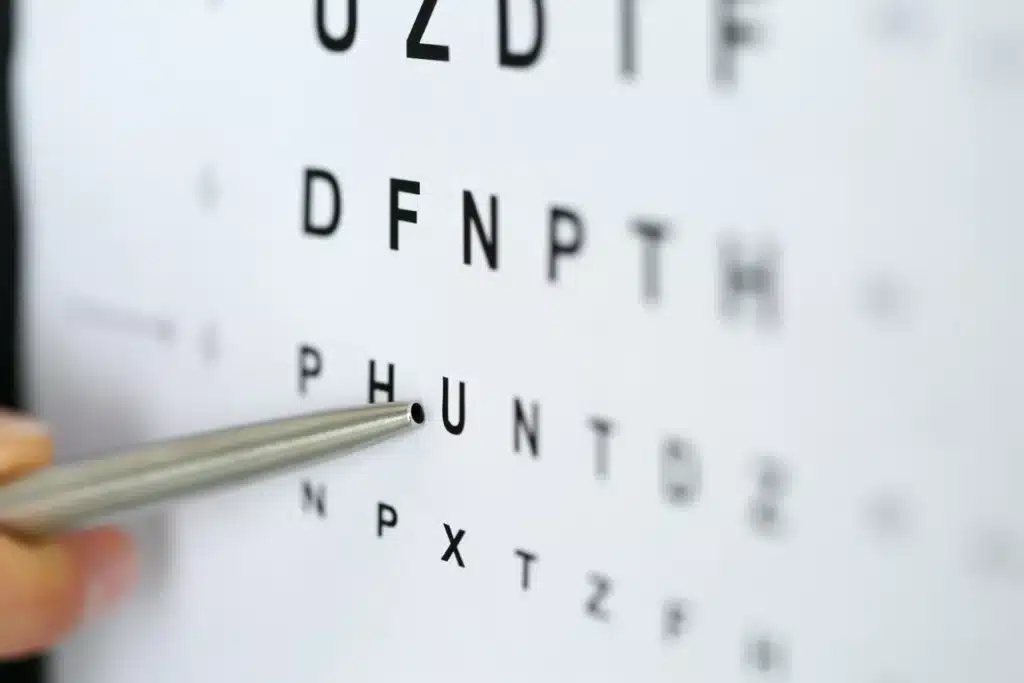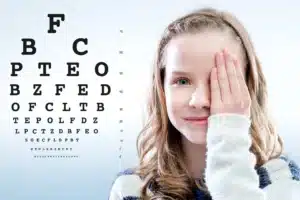One of the most common eye symptoms that many people experience on a daily basis is blurred vision. Some people experience it on and off throughout the day, while other people never get a break from it. Either way, it can have a negative impact on your quality of life.
Visual acuity is the measurement of how sharp or clear your vision is – for reference, the term ‘acuity’ means ‘sharpness or keenness.’ Those with good visual acuity have no problem seeing fine details, even from a distance. Those with poor visual acuity are left with blurred vision.
Since blurred vision is a common symptom in a number of health and eye conditions, your visual acuity is a good measurement of your eye health – albeit not the only one. It’s one of the first things your eye doctor tests for and goes a long way in detecting eye diseases early on.
What is the Visual Acuity Test?
The visual acuity test is a staple in any eye exam and is often the first vision test many people imagine when they think of the eye doctor. It utilizes something known as the Snellen chart consisting of letters – starting with large ones at the top and decreasing in size as you go down the chart.
The Snellen chart is a standardized eye chart created by Herman Snellen, a Dutch ophthalmologist, in 1862. Eye doctors use the chart to determine how well their patients can see from a set distance away – usually 20 feet (or six meters) – with one eye covered by your hand or paper.
Those that struggle with the visual acuity test might require vision correction – either through surgery or the use of eyeglasses or contact lenses. Your doctor will determine your prescription (with the visual acuity test and other exams) and your vision will likely improve immediately.
When measuring visual acuity and writing a prescription, eye doctors use two numbers in the form of a fraction – 20/20 or 20/30, for example. The top number represents how far away you were standing from the Snellen chart – this number will either be 20 (for feet) or six (for meters).
The bottom number represents how far away someone with normal vision can see that same line. While the top number won’t change (unless you read the chart from further away), the bottom number will. Ideally, you want the bottom number to be lower or equal to the top number.
With all that being said, 20/30 vision means you can see well at 20 feet what someone with normal vision can see well from 30 feet. In other words, you have below-average vision and are likely experiencing some form of vision impairment. Don’t worry, treatment options are available.
Does 20/30 Vision Require Vision Correction?
While having 20/30 vision means you have below-average visual clarity, the good news is it doesn’t always require vision correction – in fact, many people can live a happy, healthy, and rewarding life without treatment for 20/30 vision. It just means there’s room for improvement.
You should speak with your doctor to determine if you would benefit from vision correction for 20/30 vision. Generally, it’s worth considering if the impaired or unclear vision is getting in the way of your normal, everyday activities – such as work, reading, and other basic daily tasks.
Those that want to pursue improved vision, there are several options available. What works best for you will depend on the cause of your blurred vision. In most cases, eyeglasses or contact lenses will do the trick. In other cases, surgery and/or lifestyle changes might be necessary.
20/30 Vision vs. 20/20 Vision
The difference between 20/30 vision and 20/20 vision is slight, but there is a difference. 20/20 vision is what doctors refer to as ‘normal vision.’ Those that have 20/20 vision don’t necessarily need vision correction because there isn’t much that can be done to improve 20/20 vision.
20/30 vision usually doesn’t require vision correction either, but many people wear glasses or contacts to improve their vision. Again, the main difference between the two is that people with 20/30 vision can see well at 20 feet what people with 20/20 vision can see well at 30 feet.
Then there are those with 20/15 or 20/10 vision. While many people think 20/20 vision is ‘perfect vision,’ it’s not. Those with 20/15 or 20/10 vision can see well at 20 feet what people with 20/20 vision can see well at 15 or 10 feet, respectively. It’s the type of vision most people dream of.
On the flip side, you can have vision that’s much worse than 20/30 – for example, those that are legally blind have 20/200 vision. In general, anything between 20/20 and 20/60 is considered mild vision loss, while anything between 20/70 and 20/160 is moderate visual impairment.
Are You Experiencing Blurred Vision?
Blurry vision might not sound like a big problem, but it can result in a deteriorated quality of life if not treated properly in a timely manner. It not only makes it harder to read, watch television, or drive a vehicle, but it can make it hard to recognize faces of loved ones and make out details.
While 20/30 vision is far from the worst case scenario, it’s understandable why the average person might worry and we get why vision correction is often preferred. At Milwaukee Eye Surgeons, we want to make sure all patients have access to quality vision for as long as humanly possible.
If you’re experiencing vision loss symptoms, believe you might benefit from eyeglasses or contact lenses, want to monitor your eye health, or have any eye-related questions, don’t hesitate to ask! Contact our office right away and schedule a visit with our wonderful team of eye specialists – we can’t wait to help treat your vision-related problems!





